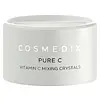What's inside
What's inside
 Key Ingredients
Key Ingredients

 Benefits
Benefits

 Concerns
Concerns

No concerns
 Ingredients Side-by-side
Ingredients Side-by-side

Hippophae Rhamnoides Water
MaskingGlycerin
HumectantWater
Skin ConditioningNiacinamide
SmoothingMethylpropanediol
SolventPropanediol
Solvent1,2-Hexanediol
Skin ConditioningButylene Glycol
HumectantDipropylene Glycol
HumectantCaprylic/Capric Triglyceride
MaskingGlycereth-26
HumectantEthylhexyl Palmitate
EmollientCetearyl Alcohol
EmollientArginine
MaskingCarbomer
Emulsion StabilisingAmmonium Acryloyldimethyltaurate/Vp Copolymer
Cetearyl Olivate
Helianthus Annuus Seed Oil
EmollientSorbitan Olivate
EmulsifyingSimethicone
EmollientPolyglyceryl-10 Laurate
Skin ConditioningEthylhexylglycerin
Skin ConditioningAdenosine
Skin ConditioningParfum
MaskingPolyacrylate-13
Glycine Soja Oil
EmollientDisodium EDTA
Polyisobutene
Hydrolyzed Sclerotium Gum
HumectantGlyceryl Stearate
EmollientGluconolactone
Skin ConditioningPolysorbate 20
EmulsifyingSorbitan Isostearate
EmulsifyingHydrogenated Lecithin
EmulsifyingBixa Orellana Seed Oil
EmollientPolyglyceryl-10 Stearate
Skin ConditioningAlpha-Arbutin
AntioxidantPanthenol
Skin ConditioningSodium Ascorbyl Phosphate
AntioxidantPentylene Glycol
Skin ConditioningFerulic Acid
AntimicrobialTocopherol
AntioxidantAscorbyl Glucoside
Antioxidant3-O-Ethyl Ascorbic Acid
Skin ConditioningBisabolol
MaskingAscorbic Acid
AntioxidantHydroxyphenyl Propamidobenzoic Acid
Skin ConditioningPyridoxine
Skin ConditioningUbiquinone
AntioxidantBiotin
AntiseborrhoeicFolic Acid
Skin ConditioningSodium Hyaluronate
HumectantAscorbyl Propyl Hyaluronate
Skin ConditioningAscorbyl Palmitate
AntioxidantCyanocobalamin
Skin ConditioningThiamine Hcl
MaskingRiboflavin
Cosmetic ColorantLinoleic Acid
CleansingBeta-Carotene
Skin ConditioningRutin
AntioxidantHydroxycinnamic Acid
Skin ConditioningHippophae Rhamnoides Water, Glycerin, Water, Niacinamide, Methylpropanediol, Propanediol, 1,2-Hexanediol, Butylene Glycol, Dipropylene Glycol, Caprylic/Capric Triglyceride, Glycereth-26, Ethylhexyl Palmitate, Cetearyl Alcohol, Arginine, Carbomer, Ammonium Acryloyldimethyltaurate/Vp Copolymer, Cetearyl Olivate, Helianthus Annuus Seed Oil, Sorbitan Olivate, Simethicone, Polyglyceryl-10 Laurate, Ethylhexylglycerin, Adenosine, Parfum, Polyacrylate-13, Glycine Soja Oil, Disodium EDTA, Polyisobutene, Hydrolyzed Sclerotium Gum, Glyceryl Stearate, Gluconolactone, Polysorbate 20, Sorbitan Isostearate, Hydrogenated Lecithin, Bixa Orellana Seed Oil, Polyglyceryl-10 Stearate, Alpha-Arbutin, Panthenol, Sodium Ascorbyl Phosphate, Pentylene Glycol, Ferulic Acid, Tocopherol, Ascorbyl Glucoside, 3-O-Ethyl Ascorbic Acid, Bisabolol, Ascorbic Acid, Hydroxyphenyl Propamidobenzoic Acid, Pyridoxine, Ubiquinone, Biotin, Folic Acid, Sodium Hyaluronate, Ascorbyl Propyl Hyaluronate, Ascorbyl Palmitate, Cyanocobalamin, Thiamine Hcl, Riboflavin, Linoleic Acid, Beta-Carotene, Rutin, Hydroxycinnamic Acid
 Reviews
Reviews

Ingredients Explained
These ingredients are found in both products.
Ingredients higher up in an ingredient list are typically present in a larger amount.
Ascorbic Acid is is pure Vitamin C. This form makes up the largest amount of vitamin C found naturally in our skin.
Not only is vitamin C great for your overall health and immune system, it also has plenty of benefits on your skin.
Vitamin C is best used for brightening skin. It improves dark spots, acne scars, and hyperpigmentation. This is because it blocks the process of skin darkening when exposed to UV.
Remember: Vitamin C should not replace sunscreen!
Your skin uses vitamin C to build collagen. Collagen is one key component in having a strong skin barrier and plump skin. Vitamin C also plays a role in regulating collagen, thus making it effective in improving wrinkles and fine lines.
Ascorbic acid shows potent antioxidant activity. As an antioxidant, it helps fight free-radicals. Free-radicals are molecules that may damage your skin cells. These antioxidants also protect skin against UV damage.
The best formulations include Vitamin E and/or ferulic acid. These two ingredients help stabilize and provide a boost in the benefits of ascorbic acid. This is because ascorbic acid becomes unstable when exposed to UV and air. In fact, you can tell your ascorbic acid has oxidized when it turns an orange-yellow color.
Ascorbic acid is generally compatible with other ingredients. However, using ascorbic acid with other active ingredients might cause irritation. Two ingredients: copper ions and benzoyl peroxide, will inactivate ascorbic acid completely.
Read more about other types of Vitamin C:
Foods rich with vitamin C include oranges, strawberries, broccoli, bell peppers, and more. When consuming Vitamin C, your skin receives a portion of the nutrients.
Learn more about Ascorbic Acid